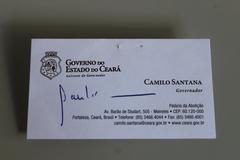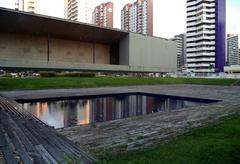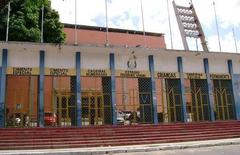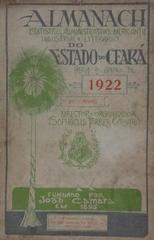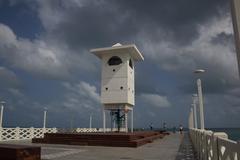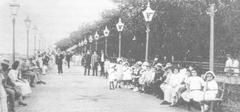Coco Park Fortaleza: Visiting Hours, Tickets, and Historical Sites Guide
Date: 04/07/2025
Introduction: The Significance of Cocó Park
Located in the bustling city of Fortaleza, Brazil, Cocó Park (Parque do Cocó) stands as the largest urban park in northern and northeastern Brazil, spanning approximately 1,581 hectares. This vast green sanctuary is a beacon of urban ecological preservation, offering residents and tourists a unique blend of diverse ecosystems, cultural heritage, and recreational opportunities. Cocó Park’s landscapes—marked by extensive mangrove forests, riverine habitats, and fragments of the Atlantic Forest—support a rich variety of flora and fauna, including numerous threatened and endemic species. The park also provides critical environmental services such as water purification, flood control, and urban temperature regulation, contributing to the city’s resilience and quality of life (123ecos.com.br; e-publicacoes.uerj.br).
Admission to Cocó Park is free, and its facilities—ranging from accessible trails and playgrounds to sports courts and an environmental museum—cater to a wide audience. Through guided tours, educational programs, and community-driven conservation initiatives, the park has evolved into a model of participatory management and sustainable urban planning (semeia.org.br; AIPH Green City Case Study).
This comprehensive guide provides essential information for visiting Cocó Park, including current hours, ticket details, accessibility, main attractions, and important historical context. Whether you seek tranquil walks, adventure, cultural events, or insights into urban conservation, Cocó Park is a destination that embodies Fortaleza’s commitment to safeguarding its natural heritage.
Table of Contents
- Introduction: The Significance of Cocó Park
- Historical Background and Evolution
- Visiting Cocó Park: Essential Information
- Conservation Challenges and Community Engagement
- Frequently Asked Questions (FAQ)
- Milestones and Recognition
- Plan Your Visit
- Summary of Key Points
- References and External Links
Historical Background and Evolution
Early Recognition and Environmental Importance
Long before its official designation, the Cocó River basin and surrounding mangroves were recognized as vital ecological assets for Fortaleza. The area’s mangroves, ciliary forests, and Atlantic Forest fragments provided essential ecosystem services, acting as nurseries for marine life and regulating the local climate. As the city rapidly expanded in the late 20th century, these habitats faced mounting threats from urban development and pollution (123ecos.com.br).
Grassroots Activism and Legal Protection
The fight to preserve the Cocó ecosystem was spearheaded by local residents, environmentalists, and civil society organizations. Their sustained activism—from public protests to legal challenges—halted destructive projects and raised awareness about the area’s ecological importance. This collective action was instrumental in securing the park’s legal recognition (blog.ecoadventure.tur.br).
Official Designation and Expansion
Cocó Park was officially designated as a state park in June 2017 by State Decree No. 32.248, after decades of advocacy (semeia.org.br). Its boundaries now encompass more than 15 neighborhoods, transforming what was once a barrier to urban growth into a vital green corridor that connects communities and supports daily recreation (arquitetosassociados.arq.br).
Restoration and Conservation Efforts
Ongoing restoration projects such as “Restaura Cocó” focus on habitat recovery, reforestation, and sustainable management. These initiatives, in partnership with schools and environmental groups, promote education and public engagement in conservation (semeia.org.br).
Biodiversity and Socio-Cultural Evolution
Cocó Park’s diverse ecosystems are home to myriad species, some threatened or endemic. Scientific studies confirm the park’s impact on urban microclimates, reducing local temperatures by up to 3°C (e-publicacoes.uerj.br). The creation of the park has reshaped Fortaleza’s relationship with its natural environment, transforming the river and green spaces into celebrated community assets (arquitetosassociados.arq.br).
Visiting Cocó Park: Essential Information
Visiting Hours
- Regular Schedule: Daily from 5:00 AM to 7:00 PM.
- Note: Some sources may mention slightly different hours (e.g., 6:00 AM to 6:00 PM). Early morning and late afternoon are ideal for cooler temperatures and wildlife activity.
Entrance Fees and Tickets
- General Admission: Free.
- Special Events and Tours: Select activities, guided tours, or workshops may require a nominal fee or advance booking (Global Adventure Guide).
Accessibility
- Pathways: Paved, wheelchair-accessible trails are available; some areas may have uneven terrain.
- Facilities: Restrooms, water stations, and parking are provided near main entrances.
- Bicycle Rentals: Available at designated park entrances.
Guided Tours and Educational Programs
- Join ranger-led tours or participate in environmental education activities, particularly on weekends and during special events.
- School groups and NGOs frequently collaborate in educational programming (semeia.org.br).
Main Attractions
- Mangrove Forests: Explore unique urban mangroves and spot native wildlife.
- Walking and Cycling Trails: Well-maintained and shaded for leisure or exercise.
- Boat Tours: Guided trips along the Cocó River offer a unique perspective on park ecosystems (TripHobo).
- Adventure Sports: Facilities for zip-lining, climbing, and pivoting bridges, operated by third-party providers.
- Amphitheater: Venue for concerts, theater, and environmental events.
- Sports Courts and Playgrounds: Family-friendly recreational spaces.
Travel Tips
- Best Time to Visit: Early morning or late afternoon for pleasant weather and active wildlife.
- What to Bring: Sunscreen, insect repellent, comfortable shoes, reusable water bottle.
- Getting There: Easily reached by public transit, taxi, or car.
Nearby Attractions
- Dragão do Mar Center of Art and Culture: Cultural hub nearby.
- Praia de Iracema and Praia do Futuro: Popular beaches.
- Mercado Central: Local crafts and cuisine.
Conservation Challenges and Community Engagement
Urbanization and Environmental Pressures
Rapid urbanization, informal settlement, and pollution place ongoing stress on Cocó Park and its ecosystems. Flooding—exacerbated by climate change—remains a persistent challenge in the Cocó River basin (Springer Link).
Restoration and Urban Micro Parks
Initiatives like the Urban Micro Parks program reclaim degraded land for multifunctional green spaces, supporting biodiversity and social inclusion. Community involvement in design, maintenance, and management is integral to these projects (AIPH Green City Case Study).
Sustainable Financing and Governance
Funding is a continuous concern; while visitors express willingness to contribute (average R$ 11.53/month), sustainable models are needed to ensure long-term maintenance without restricting access (Academia.edu). Partnerships with organizations such as the World Bank support innovative pilot projects.
Education and Shared Responsibility
Environmental education, participatory planning, and shared governance are foundational to Cocó Park’s management model. These strategies foster stewardship, community cohesion, and resilience against environmental threats.
Frequently Asked Questions (FAQ)
Q: What are Cocó Park’s visiting hours?
A: Daily from 5:00 AM to 7:00 PM (sources may also list 6:00 AM to 6:00 PM).
Q: Is there an entrance fee to Cocó Park?
A: No, entry is free. Select activities may require a fee.
Q: Are pets allowed?
A: Yes, pets are welcome on a leash.
Q: Are there guided tours?
A: Yes, guided tours and educational workshops are offered, especially on weekends.
Q: Is the park accessible for people with disabilities?
A: Yes, with paved paths and accessible restrooms in many areas.
Q: How do I book activities like zip-lining or boat tours?
A: Book directly with third-party providers or at the park’s visitor center.
Milestones and Recognition
- 2017: Official designation as a state park by Decree No. 32.248.
- 1,581 hectares: Largest urban park in northern and northeastern Brazil.
- 15+ neighborhoods: Integrated within Fortaleza’s urban fabric.
- 4th largest in Latin America: Among urban parks (blog.ecoadventure.tur.br).
Plan Your Visit
For the latest updates on events, guided tours, and conservation projects, consult the park’s official website or visitor center. Download the Audiala app and follow official social media channels for real-time information, virtual tours, and travel tips.
Summary of Key Points
Cocó Park exemplifies the potential of urban green spaces to function as ecological sanctuaries, cultural centers, and recreational venues. Its transformation from a threatened ecosystem to a celebrated public park was achieved through collective advocacy and innovative urban planning (123ecos.com.br; blog.ecoadventure.tur.br). Today, it provides vital environmental services, supports a diverse array of wildlife, and serves as a focal point for community engagement and education (e-publicacoes.uerj.br). By integrating conservation with recreation and cultural activities, Cocó Park remains a cornerstone of Fortaleza’s urban identity and a model of sustainable city living.
References and External Links
- Cocó Park Fortaleza: Visiting Hours, Tickets, and History of the Largest Urban Park in Brazil, 2025, 123ecos (123ecos.com.br)
- Cocó Park Fortaleza: Visiting Hours, Tickets, and History of the Largest Urban Park in Brazil, 2025, EcoAdventure Blog (blog.ecoadventure.tur.br)
- Cocó Park Fortaleza: Visiting Hours, Tickets, and History of the Largest Urban Park in Brazil, 2025, Semeia (semeia.org.br)
- Cocó Park Fortaleza: Visiting Hours, Tickets, and History of the Largest Urban Park in Brazil, 2025, Arq. Associados (arquitetosassociados.arq.br)
- Cocó Park Fortaleza: Visiting Hours, Tickets, and History of the Largest Urban Park in Brazil, 2025, E-Publicacoes UERJ (e-publicacoes.uerj.br)
- Visiting Cocó Park in Fortaleza: Hours, Tickets, History, and Travel Tips, 2025, Global Adventure Guide (globaladventureguide.com)
- Cocó Park Fortaleza: Visiting Hours, Tickets, Attractions, and What to Expect, 2025, TripHobo (triphobo.com)
- Discover Cocó Park: Visitor Guide and Conservation Efforts in Fortaleza, Brazil, 2025, Springer Link (Springer Link)
- Discover Cocó Park: Visitor Guide and Conservation Efforts in Fortaleza, Brazil, 2025, Academia.edu (Academia.edu)
- Discover Cocó Park: Visitor Guide and Conservation Efforts in Fortaleza, Brazil, 2025, AIPH Green City Case Study (AIPH Green City Case Study)
